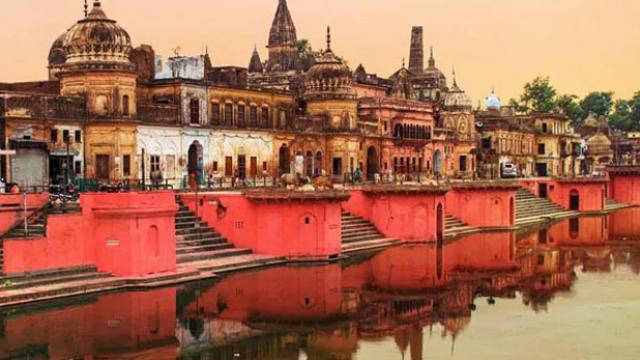Dr Ajit Jha & Dr Arvind Pandey[i]
Construction of an impressive Ram temple will, in all likelihood, start in a year after being paved by a historical judgment on the Ayodhya dispute by the Supreme Court. It will take place after nearly 500 years of struggle. Although the first recorded legal fight between proponents of temple and backers of mosque in Ayodhya dates back to November 30, 1858 when one Mohammad Salim lodged an FIR against a group of Nihang Sikhs who had written ‘Ram’ inside the Babri mosque.
Leaving the chequered past of Ayodhya behind, the apex court through its landmark judgment has given a fresh lease of life to the city which, as per eminent historian Meenakshi Jain’s book ‘Rama and Ayodhya’, was founded in ‘Satya Yuga’ by Manu, the progenitor of mankind. In coming years, on account of its religious and spiritual importance, the city is expected to get huge attraction from millions of Hindu devotees settled across the world. Then one should not forget about Ayodhya’s historical connection with South Korea and Nepal.
However, before the construction of temple will start, the city needs to be included in the Ministry of Urban Development’s HRIDAY (National Heritage City Development and Augmentation Yojna). In 2015, HRIDAY was launched with a focus on holistic development of heritage cities. Of the total 12 cities where this scheme is being implemented, Ayodhya is not among them.
According to the 2011 Census, Ayodhya is a part of Faizabad urban agglomeration and before 1981 it was a part of Faizabad-cum-Ayodhya Municipal Board. Thirty years ago, Faizabad-cum-Ayodhya Municipal Board was bifurcated into Faizabad Municipal Board and Ayodhya Municipal Board. Currently, Ayodhya is a Nagar Palika Parishad divided in to 25 wards. The total area of this city is 10.24 sq. km. The total urban population of Ayodhya city was 49,417 in 2001, which increased to 55,890 in 2011 with an annual growth rate of 1.23 per cent between 2001 and 2011.
The sex ratio of city is 763 females per 1000 males against the state average of 912. The literacy rate (78.15 per cent) is, however, slightly higher than the state average of 67.68 per cent. The workforce participation rate in the city was 31.35 per cent. A total of 48.57 per cent males and only 8.76 per cent females were in workforce in 2011.
Ayodhya Nagar Palika Parishad has total administration over 10,026 households to which it supplies basic amenities like water and sewerage. Yet basic amenities available to the city dwellers are not very satisfactory. According to the 2011 Census, a total of 23 per cent households in Ayodhya practiced open defecation. Only 69 per cent households enjoyed toilet facility within premises, of which only 71 per cent had flush/pour toilet facility with septic tanks. Hand pump was the main source of drinking water in Ayodhya city as a total of 60 per cent household used it in 2011. Only 37 per cent households had access to tap water. Similarly, only 78 per cent households used electricity as main source of lightening. Kerosene was the second important source of lightening as a total of 19 per cent households used it in 2011.
In 2014, an international airport was proposed in the Ayodhya. To this regard, a Memorandum of Understanding was signed by the Uttar Pradesh government with the Airports Authority of India (AAI). Years have passed since signing of MoU, the airport is yet to take a shape. Services available at railway and bus stations are not up to any standard. The nearest international airport is around 134 km away in Lucknow. Existing hotels and restaurants in Ayodhya fail to match even local standards, forget about meeting any international parameters on infrastructure and amenities.
These glaring lacking in basic amenities have to be addressed while setting the goal for developing the city as the key tourist place in the world. To this effect, investment has to be made for the development of the city’s infrastructure as well as road, rail and air connectivity has to be strengthened. Then on the pattern of Sabarmati river front, Saruyu river front can be developed to make the city more attractive and grand. Listing of Ayodhya under HRIDAY, will provide the city a chance to get its past glory back.
Under this scheme, the development of core heritage infrastructure such as water supply, sanitation, drainage, waste management, approach roads, footpaths, street lights and other urban centric conveniences can be improved and developed. The city has also a Faizabad-Ayodhya Master Plan which was approved by the Uttar Pradesh government in 2001 for the development of the city. Thereby at a time when the state government is planning to build a tallest statue of Lord Ram, there is also a need to implement the Master Plan for the city which, as per the book ‘Rama and Ayodhya,’ was handed over by Manu in ‘Satya Yuga’ to Ikshvaku whose clan Lord Ram belongs to.
[i] Respectively Assistant Professor at ISID, New Delhi and Post-doctoral Fellow at National Institute of Urban Affairs, New Delhi.
(The views expressed are the author's own and do not necessarily reflect the position of the organisation)

